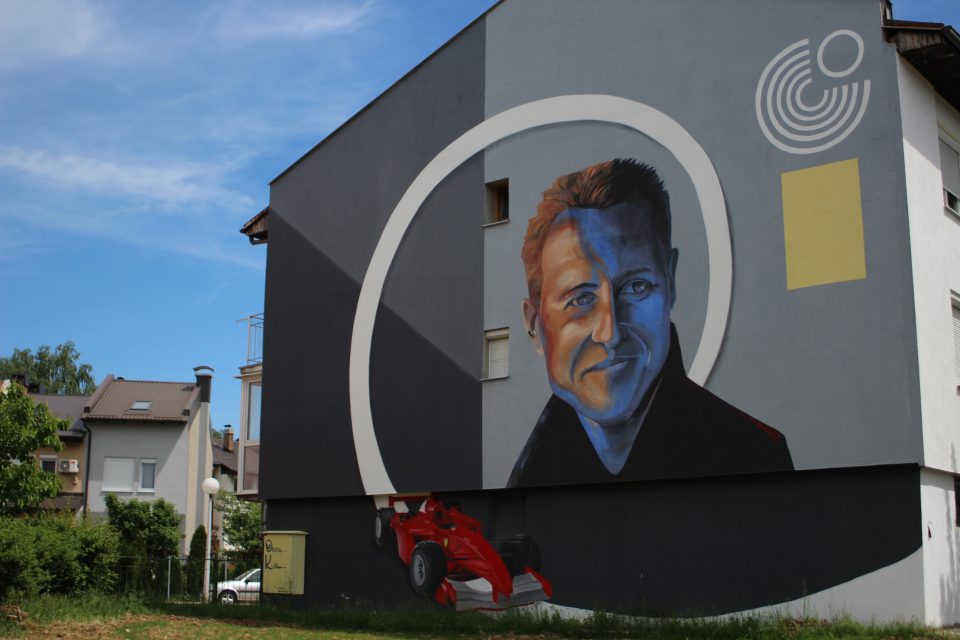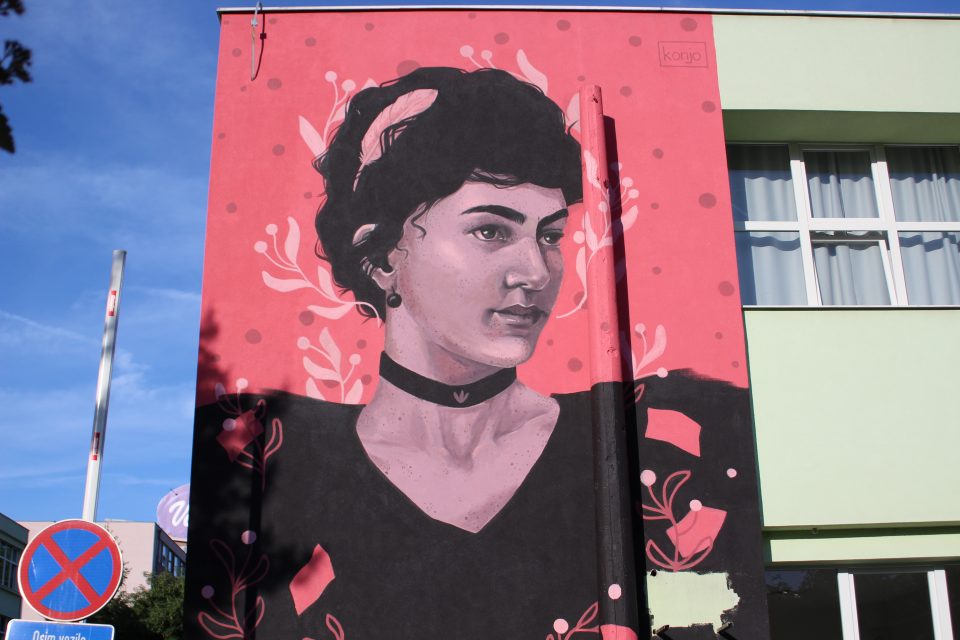
Plagued by nationalist-political narratives and rabble-rousing rhetoric, Bosnia and Herzegovina (BiH) is facing its worst political crisis since the end of the 1992-1995 conflict. However, street art in the country’s capital points to the possibility of reconciliation and peaceful coexistence in a society still polarized by the wounds of war.
With their creative street art, artists in Sarajevo are turning the capital city into one big open-air gallery. Grandiose colorful murals adorn some of the neglected and dilapidated walls along Sarajevo’s streets, sending messages of peace, friendship, and a better future, as well as emphasizing the city’s defiance and resilience. Art created as a street language is often equated with vandalism, but Sarajevo resists this attitude with artwork that overcomes the everyday grayness. The city’s murals are making a significant contribution to broadening citizens’ perceptions of artistic expression and its value.
The members of the BiH organization Obojena Klapa have played an important role in this, turning Sarajevo’s gloomy facades into works of art that are making a big impression even outside the country’s borders. The goal of this organization is to create open air art gallery on the streets of Sarajevo.
“We want to make Sarajevo a city of color and a synonym for street art in the region. This means the affirmation of this type of art in society and the recognition of its importance by our fellow citizens, the government, and other sectors of society,” said Benjamin Čengić, well-known muralist and president of Obojena Klapa.
Mirjana Ćuskić from the Helsinki Committee for Human Rights points out that art sends important messages to the social community and has the power to change social and political trajectories. “Art resists nationalism and draws attention to real problems in society, such as corruption, the non-transparent spending of public funds, political leaders’ manipulation of the media and judiciary, and so on,” Ćuskić said.
Murals as agents of the cultural remembrance
Davorin Popović, Michael Schumacher, Milena Mrazović, and Goran Čengić wave to passersby from the facades of Sarajevo’s building, taking art outside of galleries and reminding Sarajevans of the legendary personas who made lasting contributions to the BiH capital.

Čengić says that Schumacher’s mural is the least Sarajevo can do to honor the seven-time Formula 1 champion. “We decided to paint this mural because Schumacher deserves a tribute from Sarajevans to thank him for the donations and help he provided us with during and after the war. Besides, he is a person who has always given his maximum. He is a true symbol of that state of mind,” explained Čengić.
Schumacher’s mural is located at the place where the champion was photographed in 1997 with Sarajevo children who suffered injuries from war mines. Schumacher himself suffered a severe head injury in 2013, but Sarajevo has not forgotten his benevolence.
Murals in Sarajevo often appear in places of importance in the collective memory of its citizens, according to Aida Abadžić-Hodžić, professor of art history at the University of Sarajevo’s Faculty of Philosophy.
The colorful mural dedicated to the musician Davorin Popović, popularly called “Pimpek,” stands as a testament to the fact that true legends never die. In 1964, he joined the band Indexi which became an integral part of the soul of Sarajevo. With the mural, Pimpek remains forever attached to his city and part of its identity. “Murals are the identity of every city and its population. In addition to an authentic artistic urban stamp, they give the city a youthful, urban look, sending messages of cultural memory with important figures from public life, popular culture, sports,” said Sarina Bakić, a sociology professor at the University of Sarajevo’s Faculty of Political Science.

The impact of women on BiH society is evidenced by the mural dedicated to the first BiH journalist and editor, Milena Mrazović. Known in Europe as the “famous Bosnian writer,” Mrazović pushed the boundaries imposed on women at the time. The mural was painted by muralist Nataša Konjević on the building of the Electrical Engineering School for Energetics.
“As a mural painter, I appreciate the opportunity to paint portraits of important women and pay tribute to their contribution to society. Milena is just one of the women who deserves to be more present in public space,” Konjević told the media.

In addition to the murals already mentioned, the BiH capital is also distinguished by memorials like the “Sarajevo roses,” which pay tribute to the Sarajevans murdered during the longest siege of a capital city in the history of modern war. As established by the International Criminal Tribunal for the former Yugoslavia, the military and political leadership of the then Republika Srpska conducted a campaign of shelling and sniping to terrorize the citizens of Sarajevo. Ratko Mladić, the former commander of the Republika Srpska Army, was sentenced to life in prison for this campaign, as well as for his role in other crimes committed by his forces across the country.
Nonetheless, a memorial plaque dedicated to this convicted war criminal was placed at the one of the entrances to Sarajevo, located in the municipality of East Sarajevo which belongs to the entity of Republika Srpska. Despite numerous protests, damage, and formal requests for its removal, the memorial plaque still hangs on the walls of the Vraca Memorial Park for the anti-fascist fighters killed in camps and mass executions during the Second World War.

“Young people in many local communities in BiH grow up in an environment where hate speech towards others is encouraged and used every day. In this context, art is used mainly for negative purposes, like glorifying and celebrating war criminals,” said Ćuskić. She explained that street art is crucial for sending messages to young people that empower them to think about “contemporary social phenomena openly and critically and nurture a cultural remembrance for all victims equally. Street art can further encourage them to become social agents for peace and positive change in our society.”
As Abadžić-Hodžić notes, all functioning democratic societies have clearly defined mechanisms that sanction such deviant practices and provocations in public space which are a clear threat to peace and security.
Using street art to promote various messages is a very efficient strategy that can also serve, Čengić emphasizes, as a dangerous weapon used to manipulate the perception of domestic and foreign audiences.
Sarajevo’s messages of peace
The BiH capital of Sarajevo is trying in many ways to send messages of peace, friendship, and a bright future. This is how the mural “Our Future” was created, which, like a big tram, connects two cities – Sarajevo and East Sarajevo. “The mural’s message is to unite people, not to separate. It is a mural presented as an illustration of a tram with windows of stories of high school and elementary school students in Sarajevo and East Sarajevo,” said Aleksandra Nina Knežević, chief mural designer. She added that the mural’s message is mutual support, dialogue, reconciliation, understanding, friendship, and hope for the future.
The mural “Allegory of Peace and War” on the wall of the Secondary School of Economics in Sarajevo was painted by the Zagreb muralist Lonac. The eternal struggle of good and evil is represented through a girl balancing two jars: an open jar of olives, representing peace, and a closed jar containing a Siamese ‘fighter fish’ – so-called for its territorial and aggressive behavior – representing war and aggression towards one’s own people. An interesting detail is that the jar with the olives is open, while the one with the fish is closed, suggesting that now is the time for peace.
In addition to huge murals that greet passersby, inviting them to find hidden meanings, Sarajevo is also home to many works of graffiti paying tribute to the victims of the Srebrenica genocide.
“Murals are created for the general public, to occupy public spaces, and can thus be a powerful medium in promoting common values,” said Abadžić-Hodžić.
Every idea, colored by memory and inspired by humanistic values, strengthens social bonds, and enhances harmony and an inclusive sense of belonging within community. Art has proven to be an effective medium for promoting these values.
“There lies the strength of both memory and art. The sense of togetherness is one of the most important factors in the functioning of any society, and there lies the strength and important role of young people, young artists,” said Professor Bakić.







